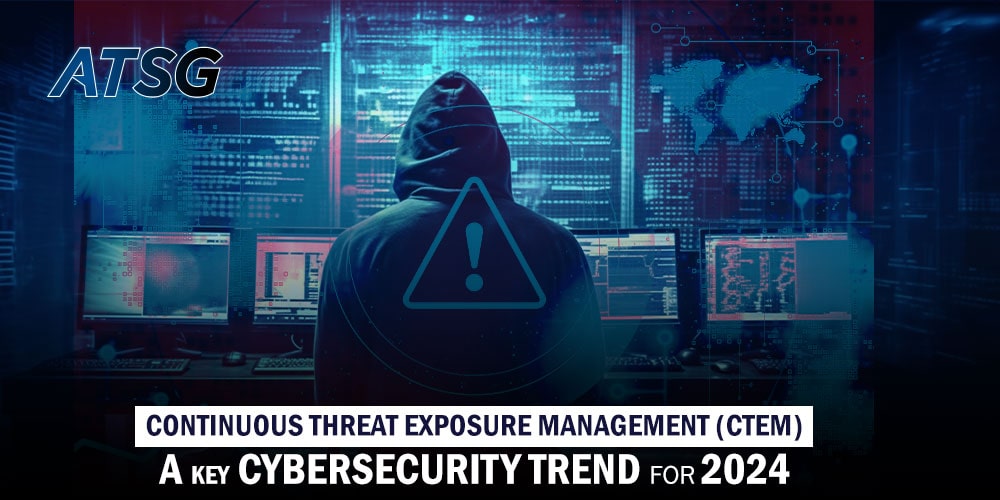Due to the ever-evolving threat landscape, businesses face significant challenges in designing and implementing a robust cybersecurity posture. As enterprises modernize their IT infrastructures to better accommodate remote work, the overall attack surface also expands. This makes it difficult for security leaders to rely on perimeter defenses alone.
This results in security gaps that need to be addressed. To keep up with growing threats, cybersecurity teams and tools require in-depth visibility to identify all risks. This can only be achieved through a well-defined strategy and meticulous execution.

To ensure the safety and security of digital assets, Gartner® has identified Continuous Threat Exposure Management (CTEM) as a top strategic technology trend for 2024. CTEM provides organizations a proactive and continuous approach to effectively manage their cybersecurity priorities.
In this blog, we will explore the key aspects of CTEM, and how it helps organizations stay safe in the face of evolving cyber threats.
What is Continuous Threat Exposure Management?
CTEM is a cybersecurity approach that involves ongoing monitoring and management of an organization’s vulnerability to potential threats. Instead of relying on reactive measures, like firewalls and antivirus software, CTEM seeks out potential flaws and threats before hackers can exploit them.
A report published by Gartner® pointed out that “By 2026, organizations prioritizing their security investments based on a continuous exposure management program will be three times less likely to suffer from a breach.” If companies fail to take action to detect and prevent potential threats and vulnerabilities, they may face even greater risks.
CTEM uses advanced analytics, Machine Learning (ML), and Artificial Intelligence (AI) to identify and prioritize threats, which helps organizations make informed security decisions, and allocate resources accordingly. Given the prevalence of cyber attacks in the digital domain, businesses need to comply with government and regulatory frameworks to achieve and demonstrate cyber resilience.
The 5 Stages of Implementing CTEM
The ultimate goal of a CTEM program and its various stages, is to have a clear set of security and risk management programs. These need to be aligned with business objectives to continuously minimize risk, improve resilience, and accelerate collaboration, ensuring a safe and secure digital environment.
The following steps identify the role played by CTEM in implementing robust cybersecurity:
1. The first step in the security program is scoping, where security teams must align with different stakeholders on business requirements, and their ultimate impact. It is essential to consider the entire attack surface of an enterprise, both internal and external, including factors such as external attack surface, digital risk, and supply chain vulnerabilities etc.
2. Next, during the discovery phase, security teams inventory assets and risk profiles based on the previous scoping process, mapping assets, vulnerabilities, misconfigurations, technology, logic, and risk.
3. Prioritization is the third step, identifying the threats most likely to be exploited by adversaries and the level of risk to the enterprise, examining exploitability, security controls, topology, risk appetite, and overall risk to the enterprise.
4. Validation is the fourth step, assessing exposure by launching controlled simulated or emulated attacks to validate exposure, existing security controls, response and remediation, testing initial foothold gains, different attack vectors, and lateral movements.
5. Finally, mobilization aims to build a defined process, so that teams can operationalize findings with minimal resistance and friction. This process requires merging security automation with IT process automation, to maximize efficiency.
The Multi-faceted Benefits of CTEM
CTEM places a strong emphasis on detecting and mitigating potential cyber threats through continuous monitoring and analysis of an organization’s digital environment. This is achieved through the use of advanced threat intelligence, security analytics, and machine learning (ML) algorithms to identify vulnerabilities and threats in real time.
The management of vulnerabilities is also a key focus, with regular assessments and testing being conducted to identify weaknesses in networks, systems, and applications.
Additionally, efficient patch management processes are highlighted as being of paramount importance, as timely deployment of security patches and updates can minimize the risk of exploitation by cybercriminals.
Furthermore, CTEM recognizes the importance of ongoing security awareness and training programs for employees, to educate them on cybersecurity best practices and safe online behaviors.
Finally, regulatory compliance is considered, with organizations being encouraged to align their security practices with relevant regulations and industry standards. These measures also give assurance to customers and other key stakeholders that their valuable data is in safe hands.
Why is CTEM Trending?
Despite using vulnerability assessment tools, organizations struggle to patch all vulnerabilities, due to some un-patchable issues. CTEM is driving technology disruptions in various markets, and a growing number of startups are offering tools to support exposure assessment and cybersecurity validation.
These tools provide more consistent, accurate, and faster remediation workflows, specialized audits of security product configurations, and support improved cross-team mobilization. A survey conducted by Gartner Peer Connect found that 71% of organizations could benefit from a CTEM approach, with 60% of respondents already pursuing a CTEM program, or considering doing so. However, implementing exposure management programs at scale, and then managing the necessary skills remains a challenge.
Future of CTEM in the Cybersecurity Landscape of 2024
CTEM enables organizations to stay safe in an evolving threat landscape, and maintain the trust of their stakeholders in an increasingly digital world. Embrace CTEM and fortify your organization’s cybersecurity defenses for a secure future. For the implementation of CTEM, it is imperative to partner with refined service providers that can address all challenges that arise across the cybersecurity landscape. Here is where ATSG’s Extended Detection and Response (XDR) capabilities come into the picture.
Contact ATSG for Managed IT Services, Cybersecurity, Technology and Cloud Computing solutions for your enterprise.




